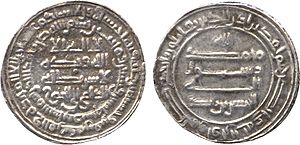Hasan ibn Zayd facts for kids
Quick facts for kids Hasan ibn Zayd |
|
|---|---|
| Emir of Tabaristan | |

Silver dirham issued by Hasan
|
|
| Reign | 864–884 |
| Successor | Muhammad ibn Zayd |
| Born | Medina |
| Died | 6 January 884 Amol |
| Issue | One daughter (possibly) |
| House | Zaydid dynasty |
| Father | Zayd ibn Muhammad |
| Mother | Amina bint Abd Allah |
| Religion | Shi'a Islam |
Hasan ibn Zayd (died January 6, 884) was an important leader. He was also known as al-Dāʿī al-Kabīr. This means "the Great Missionary." Hasan founded the Zaydid dynasty. This was a ruling family in Tabaristan. Tabaristan is a region in northern Iran. He was a descendant of Ali, a very important figure in Islam.
Contents
Hasan's Early Life and Rise to Power
Hasan was a descendant of Ali. Ali was the son-in-law of the Prophet Muhammad. In 864, Hasan lived in Rayy. This city is in northern Iran. People in the nearby province of Tabaristan invited him to lead them. They wanted to rebel against the Abbasid rulers.
Why Tabaristan Was Important
Tabaristan is a mountainous area. It is located on the southern shore of the Caspian Sea. This region was not fully conquered by Muslims for a long time. Local Iranian rulers called the Dabuyids ruled it. The Abbasids took control in 759/60. But local leaders still had much power.
Around 840, the Tahirids took over Tabaristan. They were governors for the Abbasids. This is when Islam started to spread quickly there. Most people became Sunni Muslims. But many Shi'ite missionaries also came to the area. They supported the Alids, like Hasan.
The Start of the Rebellion
In the 860s, the Tahirids ruled western Iran. Their officials in Tabaristan were very harsh. They collected too many taxes. People became very unhappy.
So, in 864, a rebellion began. It started in towns like Ruyan and Chalus. Two local leaders called "sons of Rustam" led it. They asked Hasan to be their main leader. They also allied with the Daylamites, a group from a nearby region.
Hasan accepted and took a new name. He called himself al-Dāʿī ilaʾl-Ḥaqq. This means "He who summons to the Truth." Many people in Tabaristan recognized him as their new leader, or emir. Even the king of Daylam, Vahsudan ibn Marzuban, supported him.
Challenges During Hasan's Rule
Hasan's rule was successful at first. But he faced many challenges. His land was invaded several times. He often had to hide in Daylam.
Facing Invasions
In 865, a Tahirid general forced Hasan out of Tabaristan. But Hasan returned the same year. He quickly got his province back.
Later, in 869, an Abbasid general named Muflih also forced him out. But Muflih soon left. Hasan could return again.
In 874, Hasan had a conflict with Ya'qub ibn al-Layth al-Saffar. Ya'qub was a powerful general. Hasan had given shelter to one of Ya'qub's enemies. Ya'qub invaded Tabaristan. He defeated Hasan's forces. Hasan had to flee to the mountains of Daylam again.
However, Ya'qub's army faced problems. Heavy rain and disease affected them. The climate in Tabaristan was very different for them. So, Ya'qub had to leave the region. Hasan was able to return to power.
Expanding His Territory
Hasan also expanded his control. From 867, he usually controlled Gurgan to the east. He also briefly controlled other areas. These included Rayy, Qazvin, and Qumis.
Hasan's Legacy and Character
Hasan died in Amul in 884. His brother, Muhammad ibn Zayd, became the new ruler. The Zaydid dynasty continued to rule Tabaristan until 928.
Historians describe Hasan as a fair and just ruler. He was also a very religious man. He was well-educated and supported learning.
However, his rule had some difficulties. He strongly enforced Shi'ism. This caused problems with the Sunni majority in Tabaristan. Also, his government relied on soldiers from Daylam. These soldiers were sometimes seen as harsh.
Relations with other local rulers were mixed. Some supported him, like the Qarinids. Others, like the Bavandids, were often against him. Despite these challenges, Hasan managed to keep his dynasty strong.
See also
- Caspian expeditions of the Rus'

